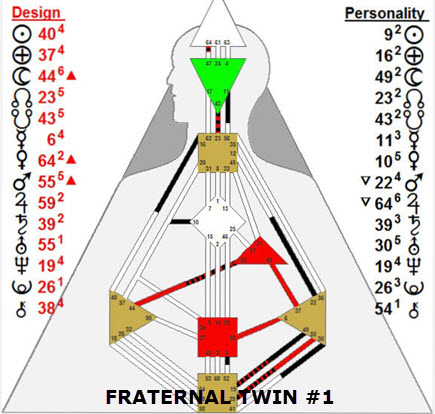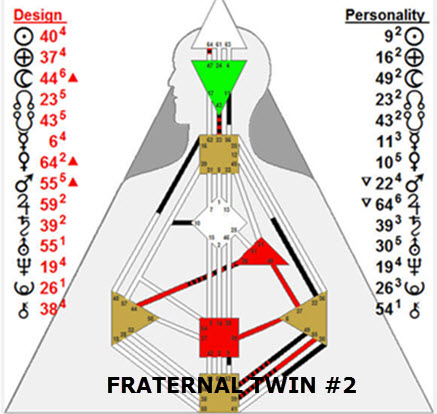I’m reaching out for clarification: My friend has fraternal twin boys, born a minute apart via C-section. Although their human design charts are identical, they present themselves in very different ways in the world. Can you offer some insights into why this is the case?
Fraternal Twin #1 is very strong-willed and argues with his mother frequently and intensely. He is very creative and mechanical. He is constantly building things out of wood, paper, and connect toys. Fraternal Twin #2 is tranquil and compliant. I have never heard him argue with anyone in the house except with his brother. Fraternal Twin #2 likes to read, and if he disagrees with something his mother says, he may walk away, or he may go to his room and cry, but he never yells at her. Whereas Fraternal Twin #1 will stand there and speak his mind louder and louder, telling his mom that she is wrong, it’s not fair, and she is lying to him…As I said, he is very strong-willed.
As you can see, they are complete opposites in how they show up in the world. As infants, their personalities were opposite to who they are now. Fraternal Twin #2 screamed and cried for the first 6 months of his life; his mother said she didn’t know if his hair was on fire or if he didn’t like the wallpaper! Fraternal Twin #1, on the other hand, was tranquil and content as an infant, just observing everything around him.
Here are my working reflections on why twins with the same Human Design chart can express themselves so differently in life.
Part I: Why Charts Express Differently
This discussion examines why Fraternal Twin #1 and Fraternal Twin #2 may exhibit dramatically different traits, despite having the same Human Design chart.
Fraternal Twin #1 and Fraternal Twin #2 are each unique, with distinct soul trajectories. Each has their own history of experience, dharmas, life purposes, and unresolved issues or karmas.
Their soul profiles, separate from their Human Design profiles, are unique. Each twin will find their own path, which will be expressed differently through their identical human design.
Twin’s charts, charts of triplets, quintuplets, etc., are great ways to deepen our understanding of how Human Design actually functions in the real-time, real lives of human beings.
The Chart is not the person or personality. Human beings are far more complex than what a Human Design chart can convey. The Chart reflects the themes and curriculum relevant to the birth moment, offering only a mechanical outline.
Our Design describes how our energy is intended to flow in this life, highlighting strengths, decision-making tools, and focus areas. These help us pursue our life plan, creative style, relationships, and meaning. Yet, how we embody purpose is shaped by much more than chart mechanics.
An important consideration: C-section births, like these twins’, are forced. The soul’s timing for entering the world can be affected, and family chart patterns can be disrupted. Michel Gauquelin, a French psychologist and astrologer, found hereditary planetary links were more common with natural births, both between siblings and between parents and children. He and his wife, Françoise, conducted thirty years of rigorous research, showing that certain astrological phenomena had high statistical validity.
Forced birth times can redirect the soul’s intentions by altering planetary placements. Each planet’s frequency and archetype are integral to a person’s journey, so its position holds significance. The guidance provided by the planetary configuration given at birth is disrupted by a C-section, forcing us to adapt to the new, but unintended, planetary setup. Perhaps Fraternal Twin #2’s early distress reflected anger at being forced into a design not reflecting his intent, and Twin #1’s frequent outrage stems from the same.
For the record, I am not issuing any judgments about C-sections. I recognize that they can be necessary to save lives. It is also possible that the soul knew a forced birth was likely and chose that situation for the growth it would catalyze.
Being born with a Human Design that is not of one’s own choosing can add a significant challenge to connecting with the intended initial themes and tools inherent to a Human Design chart. How do we connect to our authenticity and find our right path when the tools, attributes, and map that we planned on have been altered?
Given these complexities, how can identical Human Design charts produce such vast differences in personality and interests?
Why do we expect the same Design to result in similar personalities? Each individual expresses their chart through the lens of their unique history, agenda, personal identity, the culture they’re born into, the extent to which they identify with that culture, and more. These factors shape, limit, focus, and direct how a Design is embodied and expressed.
In Part II (HUMAN DESIGN: SAME CHART, DIFFERENT SOULS, PART II), we take a look at how Fraternal Twin #1 and Fraternal Twin #2 might be expressing their shared design authentically, despite appearances to the contrary.
In Part III (HUMAN DESIGN: SAME CHART, DIFFERENT SOULS, PART III), we will look at how soul purpose is identified in the twins’ design charts.
© 2015 | Gloria Constantin | All Rights Reserved |
Need help or have questions? Contact Me


Me born 1980 & my partner born 1966 have same human design graph they are almost identical. How?
Hi, Melissa. Thank you for your comment.
Even though the same planets are not in the same place as they were in 1966 and 1980, with the exception of maybe the inner planets and the Moon, similarities in charts for different birth dates can show up. However, the outer planets will occupy different gates for those two dates. In any case, I would have to see both charts — yours, and your partner’s — to be able to identify why the similarities exist. It would have been useful for you to provide the birth dates for both charts.
Peace, Gloria